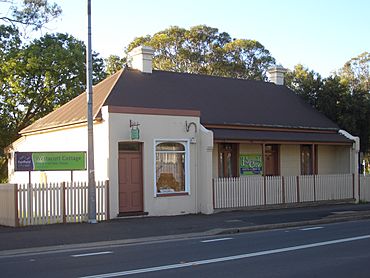Canley Vale, New South Wales facts for kids
Quick facts for kids Canley ValeSydney, New South Wales |
|||||||||||||||
|---|---|---|---|---|---|---|---|---|---|---|---|---|---|---|---|

Westacott Cottage, Railway Parade
|
|||||||||||||||
| Population | 10,216 (2016 census) | ||||||||||||||
| • Density | 3,400/km2 (8,800/sq mi) | ||||||||||||||
| Established | 1900 | ||||||||||||||
| Postcode(s) | 2166 | ||||||||||||||
| Elevation | 13 m (43 ft) | ||||||||||||||
| Area | 3 km2 (1.2 sq mi) | ||||||||||||||
| Location | 30 km (19 mi) west of Sydney CBD | ||||||||||||||
| LGA(s) | City of Fairfield | ||||||||||||||
| State electorate(s) |
|
||||||||||||||
| Federal Division(s) | |||||||||||||||
|
|||||||||||||||
Canley Vale is a suburb located in Sydney, New South Wales, Australia. It is about 30 kilometers west of the main city area of Sydney. Canley Vale is part of the City of Fairfield, which is a local government area.
Contents
History of Canley Vale
Early Life in Canley Vale
For over 30,000 years, Aboriginal people have lived in the Fairfield area. The Cabragal clan, a group within the Darug nation, were the original inhabitants. Canley Vale used to be a large woodland area. It was once part of a big property called the Male Orphan School Estate.
How Canley Vale Got Its Name
In the 1800s, a famous person named Sir Henry Parkes lived here. He was a very important politician in Australia's history. He built a large house near the railway line between Fairfield and Cabramatta.
Sir Henry Parkes named his house "Canley Grange." This name came from his birthplace, Canley, in Coventry, England. He even named the local railway station "Canley Moat House" and had his own private spot to get on and off the train. The word "Vale" means a valley or a dale.
Joining and Separating Communities
For a long time, Cabramatta and Canley Vale were seen as one community. From the 1920s, people often called the combined area "Cabravale." Some groups, like the Cabravale Diggers rugby league club, still use this name today.
In 1892, a local government area called the municipality of Cabramatta and Canley Vale was created. But in 1899, it was split into two separate areas. These two areas officially became separate on January 8, 1900. Later, in 1948, both areas became part of the larger Fairfield local government area. Canley Vale's first public school opened in 1884 and is still open today.
People and Cultures in Canley Vale
Who Lives in Canley Vale?
According to information from 2016, there were 10,216 people living in Canley Vale. About 34.8% of these residents were born in Australia. Many people living here come from other countries. The most common birthplaces outside of Australia were Vietnam (28.9%), Cambodia (6.0%), and China (4.4%).
Languages Spoken at Home
While 16.3% of people spoke only English at home, many other languages are also spoken. Vietnamese is the most common language spoken at home (35.5%). Other languages include Cantonese (9.9%), Khmer (4.9%), and Mandarin (4.8%).
Religions in Canley Vale
The main religions in Canley Vale are Buddhism (37.1%) and Catholicism (18.0%). About 17.8% of people reported having no religion.
Getting Around Canley Vale
Train Travel
Canley Vale railway station is located on the Old Main South railway line. This makes it easy for people to travel by train to and from the suburb.
Culture and Places of Interest
Arts and Crafts Centre
Westacott Cottage, found on Railway Parade, is a special place. It is home to the Fairfield City Arts and Crafts Centre. Here, people can enjoy and learn about different arts and crafts.
Temples in the Area
Canley Vale is home to several temples. Thien An Temple, a Vietnamese Buddhist Temple, is on Sackville Street. A Di Da Temple is located on Bareena Street. Minh Quang Temple is on Chadderton Street, in the eastern part of the suburb.
Schools in Canley Vale
Private Schools
Pal Buddhist School is a private school in Canley Vale. It is a co-educational school, meaning both boys and girls attend. It teaches students from primary school all the way through secondary school.
Public Schools
Canley Vale also has public schools. Canley Vale Public School is for younger students, from Kindergarten to Year 6. It even has a preschool on campus. For older students, there is Canley Vale High School, which is a government-funded secondary school for Years 7 to 12.
Sports and Fun in Canley Vale
Cabravale Leisure Centre
The Cabravale Leisure Centre is a great place for sports and activities. It's very close to the railway station on Broomfield Street. This center has a fitness area, including a 25-meter indoor swimming pool and a gym. It also has rooms for different clubs and community groups to meet. You can even find a Vietnamese martial arts class there!
Parks and Green Spaces
Canley Vale has several parks where people can relax and enjoy nature. These include Sherwin Park, Parkes Reserve, Johnston Park, and Cook Park. These parks have native plants and are near Prospect and Orphan School Creeks, offering nice green spaces for everyone.
Images for kids




